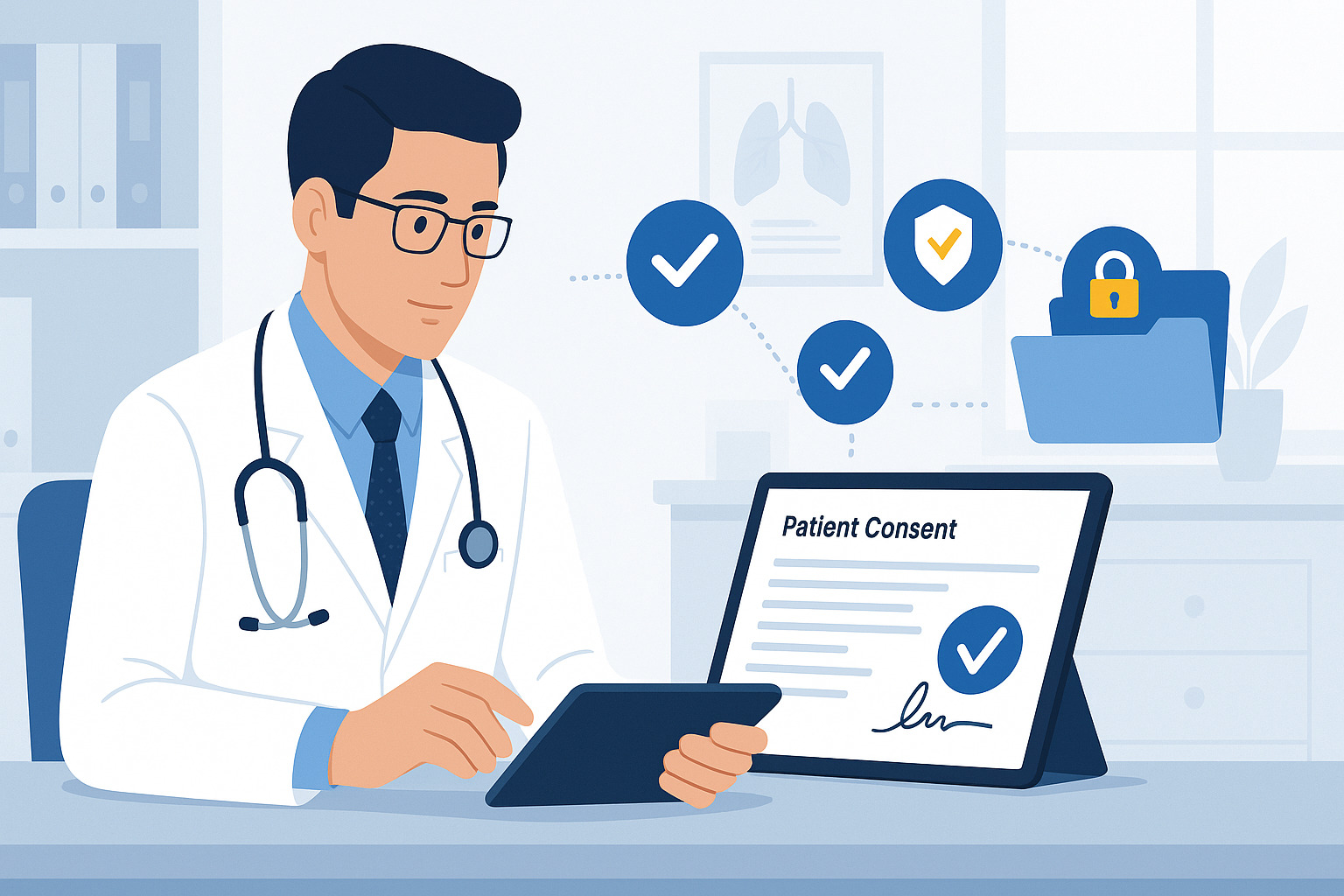Updated on: September 12, 2025
In modern healthcare, patient consent management is more than just a formality—it’s a cornerstone of trust, compliance, and ethical care. From consent for treatment and sharing health information to compliance with regulations like HIPAA, hospitals and clinicians must ensure consent is obtained, recorded, and managed accurately.
Yet, many providers still rely on outdated, manual processes—paper forms, fragmented digital records, or ad hoc systems—that lead to errors, delays, and compliance risks.
The good news? With the DocScrib AI Scribe, patient consent management becomes streamlined, secure, and seamlessly integrated inside your EHR.
What is Patient Consent Management?
Patient consent management is the process of capturing, documenting, and storing a patient’s permission to receive treatment, share health data, or participate in care decisions. It typically involves:
-
Informed Consent → Permission after explaining treatment risks/benefits.
-
Consent for Data Sharing → Allowing medical information to be used across systems.
-
Regulatory Compliance → Ensuring all consents meet HIPAA and payer requirements.
-
Audit Readiness → Having accurate records for inspections or disputes.
Without reliable systems, patient consent becomes a weak link in healthcare delivery.
Challenges of Traditional Patient Consent Management
Many healthcare teams still face hurdles:
-
Paper-Based Processes → Risk of loss, damage, or delays.
-
Inconsistent Documentation → Different formats across providers.
-
EHR Fragmentation → Consent forms stored outside clinical workflows.
-
Compliance Risks → Missing or incomplete consents lead to audit failures and denied claims.
These challenges not only slow down care but also put providers at legal and financial risk.
How DocScrib AI Scribe Enhances Patient Consent Management
Real-Time Consent Documentation
DocScrib allows clinicians to record patient consent directly within the EHR, ensuring consents are captured accurately and instantly accessible.
Seamless Integration with Clinical Notes
Consent information becomes part of the clinical document workflow—linked to SOAP notes, progress notes, or treatment plans.
ICD-10 Coding Alignment
When consent relates to a treatment or procedure, DocScrib automatically aligns documentation with ICD-10 coding requirements—ensuring both compliance and billing accuracy.
Secure, HIPAA-Compliant Storage
All consent records are encrypted and HIPAA-compliant, protecting both patient privacy and provider accountability.
Transparency Across Care Teams
Consent status is visible to the entire care team in real time, reducing confusion and ensuring consistency across departments.
Why Patient Consent Management Improves Care Outcomes
When handled properly, patient consent management delivers multiple benefits:
-
Trust & Transparency → Patients feel confident in their care.
-
Reduced Risk → Providers minimize legal and compliance issues.
-
Operational Efficiency → Teams spend less time searching for forms.
-
Improved Billing Accuracy → Claims are less likely to be denied for missing consent.
With DocScrib AI Scribe, these benefits become part of the everyday workflow.
DocScrib vs. Heidi Consent Management
| Feature / Capability | DocScrib AI Scribe | Heidi |
|---|---|---|
| Real-Time Consent Capture | ✅ Captures consent digitally during patient encounters | ⚠️ Limited, often requires manual entry |
| Integration with Clinical Documents | ✅ Consent data linked directly to SOAP notes, progress notes, and treatment plans | ⚠️ Separate from primary documentation |
| ICD-10 Coding Alignment | ✅ Aligns consent records with procedures and ICD-10 codes for billing accuracy | ❌ No ICD-10 linkage in consent workflows |
| EHR Integration | ✅ Consent stored securely inside EHR, visible to all team members | ⚠️ May require external modules or manual upload |
| Audit & Compliance Readiness | ✅ HIPAA-compliant storage, transparent tracking, audit-ready | ⚠️ Partial; relies on separate documentation |
| Team-Wide Visibility | ✅ Consent status visible to entire care team in real time | ⚠️ May not sync across teams instantly |
Benefits for Different Healthcare Stakeholders
For Clinicians
-
Record patient consent without leaving workflow
-
Ensure accurate linkage to procedures and codes
-
Reduce after-hours administrative tasks
For Hospitals
-
Reduce claim denials from missing consent
-
Improve audit readiness and compliance confidence
-
Centralize documentation for team access
For Medical Consultants
-
Access structured consent data instantly
-
Improve oversight of compliance processes
-
Enhance patient engagement and trust
Getting Started with Patient Consent Management on DocScrib
-
Book a Demo → Schedule Your Demo Here
-
Integrate with Your EHR → Smooth, minimal setup required.
-
Train Your Team → Quick onboarding thanks to Docscrib’s intuitive design.
-
Go Live → Start managing patient consent in real time.
FAQs
Q1: How does Docscrib capture patient consent?
It records consent digitally during encounters and links it to the patient’s clinical documents.
Q2: Is Docscrib HIPAA-compliant for consent storage?
Yes, all data is encrypted and stored in compliance with HIPAA regulations.
Q3: Can DocScrib track consent across multiple visits?
Absolutely. Consent data is stored longitudinally, making it easy to track across patient history.
Q4: Does Docscrib support specialty-specific consent forms?
Yes—customizable workflows allow specialty practices to tailor consent management.
Q5: How does this help with billing and compliance?
By ensuring ICD-10 alignment and complete documentation, Docscrib reduces billing errors and compliance risks.
Conclusion: Smarter Patient Consent Management with DocScrib
Patient consent is the foundation of ethical, legal, and compliant care. With the DocScrib AI Scribe, healthcare teams can manage consent accurately, securely, and in real time—inside the EHR.
The result? Greater trust from patients, fewer compliance headaches for providers, and better outcomes for all.
👉 Ready to transform patient consent management? Book a Demo with Docscrib
